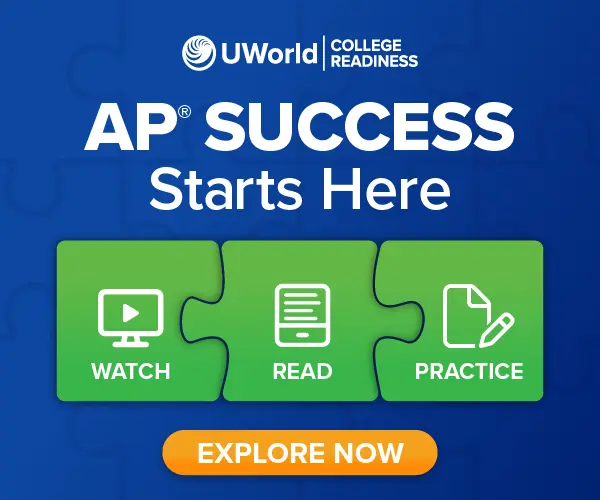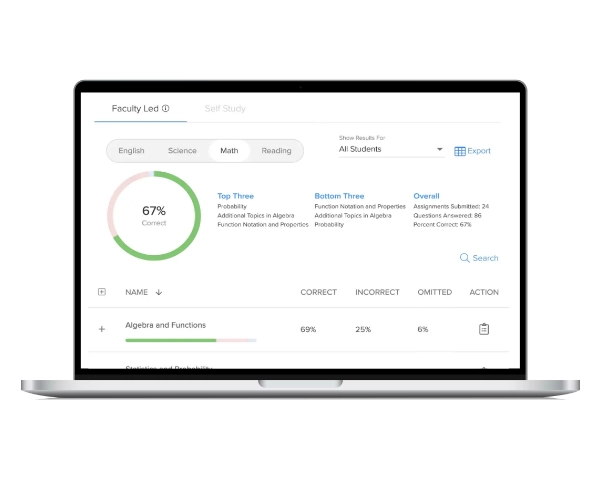Advanced Placement® (AP) programs have significantly grown in popularity. Expanded course offerings and broadened course access have led to a 65% increase in high school graduates who took an AP exam during the past decade. Despite this, there is often a disconnect between teacher expectations of students classroom behavior and academic readiness.1
By revealing 8 misalignments with real teacher insights, we're giving first-time AP educators realistic expectations so they can enter the classroom prepared to help students succeed.
#1 Student Types
Expectation: AP Classes Are Only for Honors or Gifted Students
An assumption is that every AP student has a 4.0 GPA or plans to attend an Ivy League school. AP programs feature the most challenging courses, so teachers frequently expect students to be adept writers, capable problem solvers, skilled test takers, and self-motivated learners.
Reality: Students from Varied Backgrounds and Skill Levels Take AP Classes
While some students may be ambitious first-timers seeking college credit, others might not be as academically inclined or fluent in English. As a result, teachers manage a classroom that includes passionate high achievers, reluctant participants, English as a Second Language (ESL) students, and those who need additional support in developing critical thinking and study skills.
| ✅ | Taking action: Diverse classrooms call for diverse teaching strategies, which could include group discussions, peer teaching, and interactive activities. When teachers' classroom expectations reflect real student demographics and understand learning styles, they can adapt early and build stronger, more inclusive AP instruction from day one.2 |
#2 AP Coursework
Expectation: Students Will Do Coursework Outside Class
AP programs are rigorous by design. Homework, readings, and prep are essential for success. Many teachers envision students diving into assignments after school, engaging with textbook chapters, or reviewing practice questions independently.
Reality: Students Rely Heavily on Class Time
Between extracurricular activities, part-time jobs, family obligations, and coursework for other classes, students often struggle to study outside the classroom. Additionally, some students may not yet have the self-management skills or academic habits needed to study independently. AP teachers must often build in time during the school day to reinforce concepts and check for understanding.
| ✅ | Taking action: Since teachers design their own AP courses (within guidelines to ensure that they meet college-level instruction standards), they can restructure coursework as they see fit.3 |
#3 Teacher Workload
Expectation: Teacher Workload Will Be Manageable
Teachers may assume that planning and grading will be more efficient in AP classes, given the advanced content and motivated students. With fewer behavioral issues and deeper discussions, the expectation is that the workload will be challenging but reasonable.
Reality: AP Requires Significant Additional Planning and Grading
Grading long-form essays and free-response questions is time-consuming and often done outside school hours. Teachers also spend considerable time crafting rigorous assessments, adapting materials to college-level expectations, and keeping pace with curriculum changes.
| ✅ | Taking action: To help streamline AP curriculum development, teachers can use UWorld's pre-built, time-saving instructional resources. |
#4 AP Motivations
Expectation: It's All About the College Credit
Many new AP teachers assume every student aims to score a 3, 4, or 5 on the AP Exam to earn college credit, save on tuition, and skip introductory classes. This expectation can lead teachers to structure their entire course around the exam and expect students to be equally driven to perform.3
Reality: Students Take AP Classes for Many Reasons
Students enroll in AP courses for many personal, academic, and social reasons. Some are genuinely motivated by the potential for college credit or admissions advantages. Many aren't aware of comprehensive AP benefits and may take classes because they were encouraged by a counselor, felt pressure from caregivers, want to be in a class with friends, or are trying to boost their GPA.
| ✅ | Taking action: Recognizing that not every student is exam-focused allows educators to meet students where they are and help them connect the work to their own goals. |
#5 Teacher Support
Expectation: Adequate Support and Resources Are Readily Available
First-time teachers assume administrators will be a consistent support system and expect onboarding, budgeting solutions, scheduled check-ins, and quick approval for curriculum needs. Educators may also request mentorship, direction for course planning, or access to current textbooks, lab equipment, or technology designed for AP curriculum implementation. The belief is that teaching AP is a shared priority, with leadership ensuring that students and teachers have what they need to succeed.
Reality: Leadership May Not Prioritize AP Programs
AP programs sometimes fall by the wayside in broader school planning, receiving fewer resources and less attention from school administrators. This is usually due to other matters taking precedence, like school-wide initiatives, accountability benchmarks (e.g., state assessments), staffing concerns, or compliance issues.
| ✅ | Taking action: For additional support, teachers can lean on College Board's AP Classroom resources or Advanced Placement Summer Institutes (APSIs) to develop teaching skills, learn about the AP Exam, and explore other resources.45 |
#6 Student Behavior
Expectation: AP Classes Are Easier to Manage Behaviorally
Similar to their assumptions about students' academic profiles, new AP teachers often expect students to be mature, self-motivated, and well-behaved, requiring little classroom management. With their academic drive and commitment, these students are seen as naturally engaged and responsible.
Reality: Behavioral Challenges Can Still Arise
AP students face intense pressure that can lead to unique behavioral issues. Stress and burnout may cause emotional outbursts, disengagement, or academic dishonesty.
| ✅ | Taking action: Teachers must often balance high expectations with empathy, supporting student well-being while maintaining rigor. It's important to recognize that AP students are still adolescents with unique mental and emotional needs. |
#7 AP Exam Prep Schedule
Expectation: AP Exam Prep Will Go According to Schedule
Many teachers expect to move through the content at a steady pace, wrapping up early enough to focus on review and practice. Ideally, the final weeks are reserved for reinforcing key skills and building student confidence.
Reality: Timing Challenges Are Common
School events and varied student learning speeds often push pacing off track. With limited time and dense material, teachers must find creative ways to embed exam prep throughout the year. They may even sacrifice review time to cover essential content.
| ✅ | Taking action: Teachers can use College Board's sample subject-based pacing guides and official AP school-year timeline to stay on track and anticipate potential setbacks. |
#8 Parental Support
Expectation: Parents Will Support Students in Their Advanced Studies
Given the challenge of AP coursework, it's easy to assume that students' families will be actively engaged. New AP teachers might expect them to monitor grades, encourage study time, and advocate for academic needs.
Reality: Parents May Be Uninvolved, Unaware, or Absent
Some parents may be unfamiliar with the structure or value of AP programs. Others juggle multiple jobs or responsibilities and simply can't offer academic support at home. In some cases, language barriers can also create distance between home and school.
| ✅ | Taking action: Besides in-person support, AP teachers must find ways to communicate effectively with families while maintaining student independence. Teachers who encourage parents to have a strong presence in their children's academic life contribute to higher educational achievement, school engagement, and motivation.6 |
New AP teachers arrive on their first day of class with assumptions about students' academic standing, administrative support, anticipated workload, and more. When their expectations don't align with the reality of teaching AP, they must rely on different strategies to stay ahead of the curve and help students reach their educational goals.
UWorld can ease the burden of first-time AP instruction. With high-impact instructional tools, data-driven insights, and rigorous exam prep, our proven resources are built by experts, loved by teachers, and trusted for AP achievement.
Frequently Asked Questions (FAQs)
Do expectations vs. realities differ significantly between AP subject areas?
Yes. Depending on the subject area (e.g., AP English Literature and Composition versus AP Science), teachers may face distinct challenges in workload, student coursework expectations, and other areas.7
How do experienced AP teachers help newer colleagues set realistic expectations?
They can be trusted mentors, offering proven instructional methods and constructive feedback. This can include observing new teachers, collaboratively reviewing lesson plans, and using research-based rubrics.8
What metrics can help AP teachers set more realistic expectations from the start?
Teachers can use regular progress checks (e.g., unit exams and quizzes), class participation tracking, and prior academic records to set realistic expectations for themselves. See How Teachers Can Use Performance Data to Support AP® Student Success.
Read More Related Articles
Understand why digital platforms give students an edge on AP exams. Students will have personalized practice, real-time feedback, and tools aligned with modern testing formats.
Proven Strategies That Help AP StudentsGet practical, research-backed strategies to prepare students for digital AP exams. Help students build confidence, tech readiness, and stronger test-day performance.
Progress Monitoring in AP ClassesLearn effective ways to track AP student progress. Use checkpoints to guide instruction and keep learners on pace for exam success.
References
- College Board. (n.d.). Expanding access: The impact of AP. AP Central. https://apcentral.collegeboard.org/about-ap/start-expand-ap-program/expand-access/impacts
- Stanford Teaching Commons. (n.d.). Overview of inclusive teaching. Stanford University. https://teachingcommons.stanford.edu/teaching-guides/inclusive-teaching-guide/getting-started-inclusive-teaching/overview-inclusive
- College Board. (n.d.). About AP: AP at a glance. AP Central. https://apcentral.collegeboard.org/about-ap/ap-a-glance
- College Board. (n.d.). AP Classroom overview. AP Central. https://apcentral.collegeboard.org/instructional-resources/ap-classroom/overview
- College Board. (n.d.). AP Summer Institutes. AP Central. https://apcentral.collegeboard.org/professional-learning/ap-summer-institutes
- Epstein, J. L. (n.d.). Parental involvement in student academics [PDF]. Johns Hopkins University.
- Agyapong, B., Obuobi-Donkor, G., Burback, L., & Wei, Y. (2022). Stress, burnout, anxiety and depression among teachers: A scoping review. International Journal of Environmental Research and Public Health, 19(17), 10706. https://doi.org/10.3390/ijerph191710706
- College Board. (n.d.). AP Mentoring: Program expectations & commitments [PDF]. College Board.












